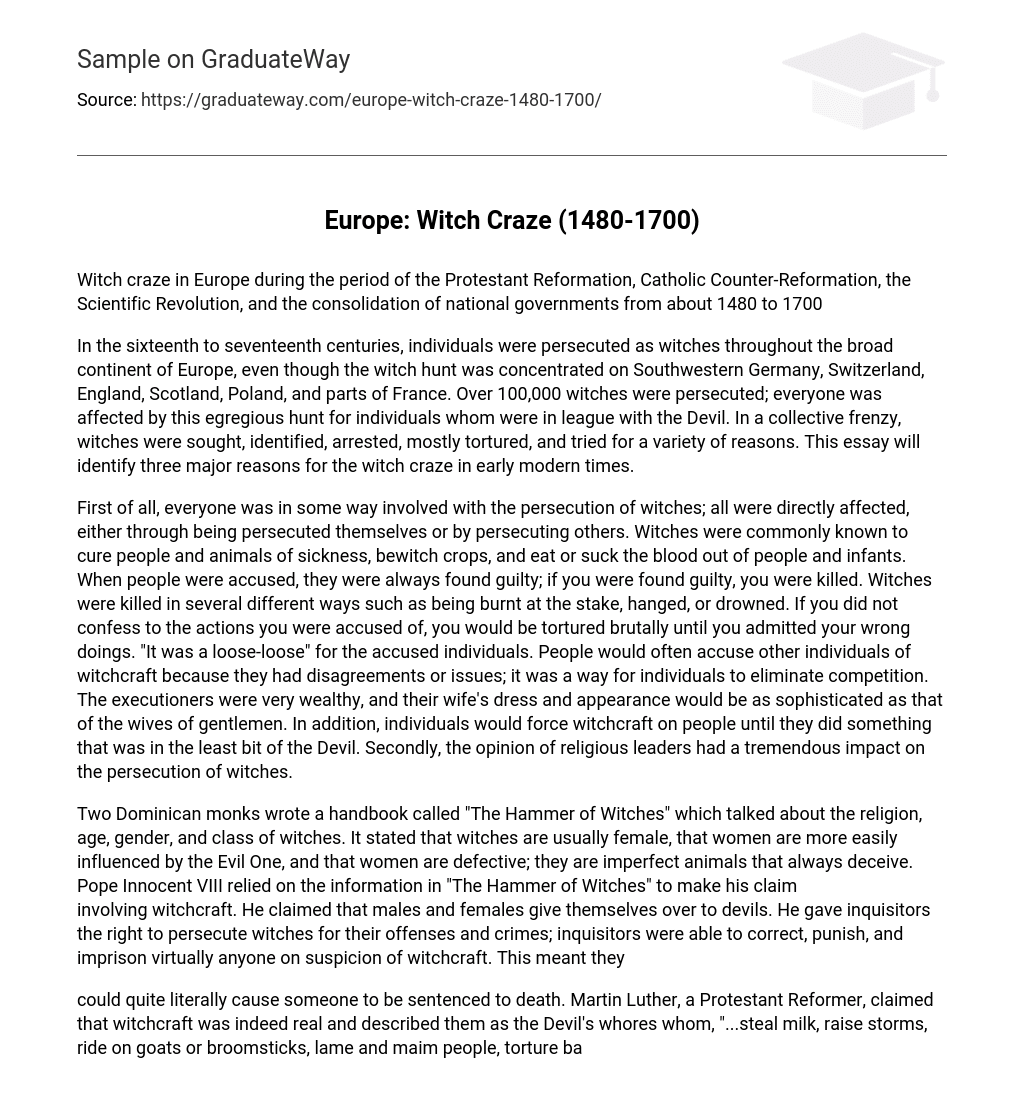Between 1480 and 1700, Europe experienced a widespread witch hunt alongside other significant events such as the Protestant Reformation, Catholic Counter-Reformation, Scientific Revolution, and consolidation of national governments.
The witch craze that occurred in Europe during the sixteenth to seventeenth centuries had a significant impact on society. Witch hunts were widespread and targeted regions such as Southwestern Germany, Switzerland, England, Scotland, Poland, and parts of France. Over 100,000 people were affected by these events. This essay will examine three key factors that contributed to the escalation of the witch craze during this time.
At the start, everyone was involved in the persecution of witches, either as victims or persecutors. Witches were believed to possess supernatural powers like healing the sick, bewitching crops, and even harming people and infants by draining their blood. Those accused were always deemed guilty and faced death as a consequence. Execution methods included burning at the stake, hanging, or drowning. Those who refused to confess were brutally tortured until they admitted their supposed wrongdoings. This created a lose-lose situation for the accused. Often, individuals would falsely accuse others of witchcraft to eliminate competition or settle personal disputes. The executioners were wealthy; their wives dressed and behaved elegantly just like those of gentlemen. Additionally, religious leaders played a significant role in influencing witch persecution.
“The Hammer of Witches,” a handbook authored by two Dominican monks, delved into the religious beliefs and characteristics of witches, including their age, gender, and social class. The book emphasized that witches are primarily female and claimed that women, being more susceptible to malevolent influences, possess inherent flaws that make them prone to deception. Pope Innocent VIII heavily relied on the information presented in “The Hammer of Witches” to support his assertions about witchcraft. He maintained that both men and women willingly aligned themselves with demons. As a result, the Pope granted inquisitors the power to persecute witches for their transgressions and illegal activities. These inquisitors were authorized to interrogate, punish, and imprison anyone suspected of practicing witchcraft, thus granting them significant control.
During the sixteenth to seventeenth centuries, belief in witches was widespread and had severe consequences, including death sentences. Martin Luther, a Protestant Reformer, considered witches to be the Devil’s whores and blamed them for various supernatural acts like stealing milk, causing storms, and tormenting infants. John Calvin, another Protestant reformer, advocated for waging war against witches. The fact that even respected religious figures held such beliefs shows the pervasive obsession with witchcraft. This obsession affected ordinary individuals as well; a young Protestant boy’s diary describes terrifying hallucinations of devils constantly pursuing him. This intense fixation on witchcraft caused people to become delusional and paranoid. Even highly educated individuals believed in witchcraft, though they differed in their approaches to handling it. In England, one lawyer regarded elderly individuals as diseased and impure carriers of evil contagion.
The author, a medical doctor from Belgium, argues that elderly and senile women, who are easily influenced by the Devil, should not be sent to prison. This is because prisons are believed to house evil spirits that would worsen their condition. It is worth noting that even educated individuals believed in witchcraft. There is also statistical evidence regarding the age, gender, and social class of witches. The husbands of accused witches were mostly laborers and farmers. Gentlemen and nobles were rarely targeted with accusations; instead, they often made accusations themselves to improve their social status. In certain parts of Germany, Switzerland, and France, about 20 percent of those executed for witchcraft were male while approximately 80 percent were female. Moreover, individuals persecuted as witches in Switzerland, Germany England, and France tended to have a median age of 60.
The persecution of individuals as witches in Europe during the sixteenth and seventeenth centuries was influenced by several factors, such as religious beliefs, public opinion, peer pressure, and aspirations for social advancement.
During the 16th and 17th centuries, a significant portion of the population held different religious beliefs. Both religious leaders and their followers commonly believed in witchcraft and saw persecuting witches as aligning with God’s teachings. Witch trials were also driven by public opinion, peer pressure, and the need to avoid personal accusations. Accusing someone of being a witch could lead to social advancement, as it would result in a death sentence for the accused. These factors contributed to a collective frenzy in searching for, identifying, arresting, torturing, and prosecuting alleged witches.





